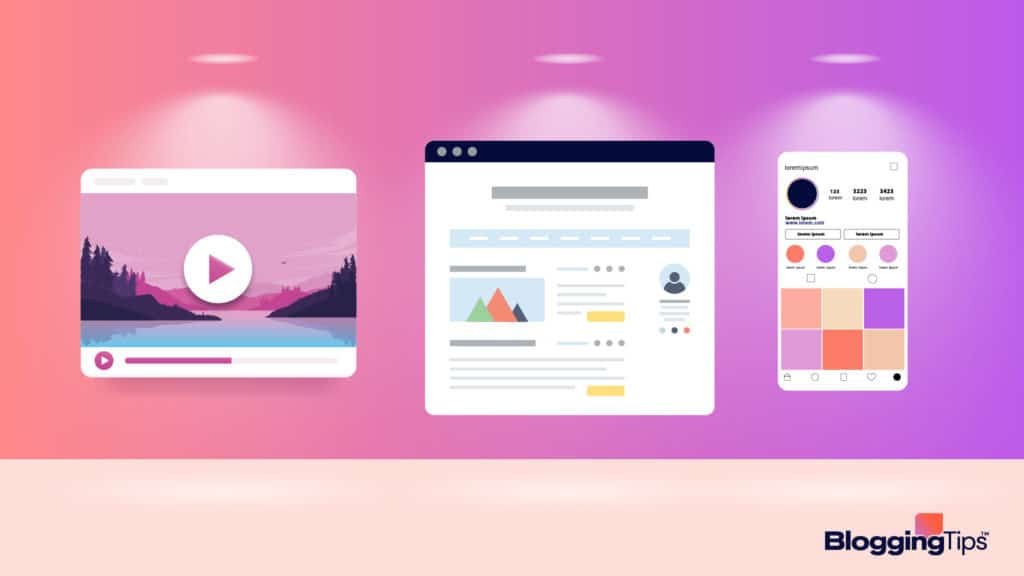Blogging nowadays is far from what it used to be several years ago.
Currently, it’s a huge and somewhat complicated industry, and a successful blog content strategy is a sure way to make you a fortune.
Establishing a consistent blog is a crucial marketing tactic that helps drive more traffic to your site.
It also aids in magnifying and expanding brand awareness.
Keep reading to know all details about content strategy, how to create one, what the different content types are, and how to find content ideas.
What Is Content Marketing?
Content marketing is an online marketing strategy that’s used to attract and stimulate interest in a certain product or brand without explicitly promoting it.
It’s mainly done by creating and sharing relevant content through different types of media, such as videos, posts, blogs, podcasts, and so on.
What Is a Blog Content Strategy?
Basically, a booming blog content strategy is based on the target audience, the product, and the content that connects both of them.
The target audience is the potential customer base that you want to attract into purchasing your products or services through your blog.
The product is typically tailored to your specific audience’s needs.
It’s, by far, the most important element of your content.
The content that connects both your target audience and the product/service you’re promoting is what helps establish a link between a problem your target is facing and an effective solution that your product or service provides.
Why Is Content Strategy Important for a Blog?
A strong content strategy is important for your blog because it helps you improve your marketing and ranking results.
It also enables you to understand who the audience you intend to reach is and get a grasp on the problems or concerns they might have.
In turn, a content strategy helps you figure out the content you need to create and the goals you want to achieve.
Additionally, a solid content strategy helps with the following:
- Makes content creation easier.
- Helps with audience targeting.
- Improves consistency as well as branding.
Categories of Content
There are several content categories out there, each with a different business application.
In this section, we’re going to address five of those content categories.

1. Transactional Content
Transactional content is basically any type of content that enables you to meet your company’s business goal at the point of purchase.
Any business aims to create revenue, and transactional content is the tool that drives online audiences to take desirable action.
The action can be anything from contacting the business or buying a product to downloading, signing up, or registering for a service.
Transactional content can be anything from plain text to promotional videos.
The main purpose is to “transact.”
Creating great transactional content will, in turn, result in sales growth.
It doesn’t matter if your content is directed toward a business-to-business audience (B2B) or a business-to-consumer audience (B2C); it’s a win-win situation with transactional content.
2. Informational Content
Informational content is helpful when someone is looking for a certain piece of information.
The goal of informational content is to provide answers to queries and issues related to your field of industry.
The main objective of creating this type of content is to be recognized as an expert in your area and be known as the most trusted source for answers.
This way, you ensure that the searcher will be more willing to read your promotional content and more likely to believe it.
Did you know that approximately 50% to 80% of search queries are informational?
As important as informational content may be, most sites have a really small amount of it posted on them.
What they don’t know is that they’re missing out on a great chance to apprehend search market shares.
3. Evergreen Content
Evergreen content is a type of informational content that is and continues to be relevant to searchers regardless of the time frame.
It got its name from the evergreen trees that never lose their leaves no matter what season it is.
When it comes to value, this type of content never loses traffic and constantly attracts interest for years, unlike time-sensitive content that is only relevant to the current situation, day, event, season, or even month.
Some topics never get old and always stay relevant to the reader.
These topics include food, romance, health, weight loss, parenting, pet care, careers, and finance.
4. Thought Leadership Content
Thought leadership is an approach to creating content that differentiates your brand from others.
It gets your company seen as a leading authority in your industry field.
In addition, it makes the audience look to you as the most trusted source of relevant information.
As the author, researcher, and thought leader Adam Grant puts it, “Creating knowledge for the purpose of sharing it is thought leadership.”
Thought leadership is to be pursued only when your brand has the successes, innovations, and reputation to back it up.
Only then will your company have earned the industry’s trust to start this specific type of content.
5. Viral Content
Viral content, as its name suggests, is a type of content that spreads rapidly, and before you know it, it gets millions of engagements and shares.
It can be anything from an article to a video or an image.
It’s something memorable, relatable, and shareable that’s designed for circulation.
For this specific type of content, it’s not necessary to run a paid ad campaign because all these people are sharing your content online for free.
Consequently, you’ll save money on marketing and boost your return on investment (ROI).
It’s basically the digital version of the old known term “word of mouth.”
Types of Blog and Website Content
Many types of online content can be shared on different platforms.
Below are some of the most notable types of blog and website content.

1. Website Content
Website content is mainly anything the user sees on your website.
It can be the “About Us” page, your landing page, privacy policy, 404 page, and everything in between.
Website content is a comprehensive term for what lies beneath.
That’s because websites contain almost every type of content.
Here are seven examples of many types of effective website content:
- Landing pages
- Testimonials
- Calls to action
- Blogs
- Content assets and supporting content
- Visual content
- Audio and video content
2. Blog Content
Blogging is an essential tool in driving visitors to your site as well as building awareness about your brand.
It’s a great way to connect with users and provide them with the information they need to solve a problem they have.
Blog content is also a fantastic way to keep your website fresh and updated.
Additionally, it enables you to post new content regularly and helps you continue ranking on search engine result pages (SERPs).
There are over 40 different types of blog content, which include:
- Listicles
- Video and written tutorials
- How-to guides
- Checklists
- Case studies
- Infographics
- Product reviews
- FAQs
- Recipes
3. Social Media Content
Social media content, just like website content, is anything you share on social media.
This can be text, video, audio, or a photo.
Either way, any content you share on your social media should be a reflection of your brand’s voice and values.
4. Supporting Content and Content Assets
This broad category of web content includes a few examples, including product brochures, slide presentations, user manuals, ebooks, podcasts, and webinars.
Those are a type of collateral resources that you already have and want to repurpose with the intention of helping draw visitors to your website.
Your goal is to extend the value of these resources by using them across different channels.
It can be broken up into smaller parts and distributed in new methods, for example, blog posts, tweets, search engine ads, video clips, and so forth.
5. SEO Content
The word “SEO” refers to search engine optimization.
Basically, it’s optimizing your website so that it can be easily found using search engines such as Google.
“Content,” as mentioned before, is any type of information that is on the web.
SEO content is any type of content that helps attract search engine traffic to your website.
In order to accomplish that, you need to research keywords that have a high amount of search volume.
Then, you need to know where and how to use them for maximum searchability.
How to Create a Blog Content Strategy?
There are a few steps to creating a successful blog content strategy, which are:
- Define your goals and objectives. Defining your goals helps give you the motivation to kickstart your project and to push through the following steps.
- Set metrics to keep tabs on your goals. Your key metrics should be closely tied to the goals and objectives you’ve set, like month-on-month revenue growth, for instance.
- Understand your audience. Researching your audience and their needs is essential to identify what content and message they care about.
- Define content types. Defining the different content types and when to use each one is extremely important for garnering the desired traffic.
- Determine content budget and timeline. Decide how much you’re willing to spend and plan the timeline accordingly to avoid any shortages.
- Create a content calendar. Create a written schedule of your upcoming content to keep everything organized and well-planned.
- Do keyword research. Keyword research is essential to creating content, especially SEO content, to ensure maximum searchability.
- Generate topic ideas. Keep a list of topic ideas no matter how bad they are, and develop new topics from old ones.
- Produce quality content. Work on creating attractive, engaging, trustworthy, and easy-to-read content.
- Interlink the new content with existing content. Internal linking is a powerful tool when it comes to reinforcing your authority.
- Share and promote the content. Promoting is a key part of creating a content strategy, and there are several ways to promote your content effectively.
- Update content with time. Updating your content over time is best for user experience and good for SEO, too. Not to mention that it helps your content stay relevant.
- Track your results. Monitor your results by measuring website traffic, engagements, conversions, authority, and SEO performance.
Where to Find Content Ideas?
Content ideas don’t just pop inside your head, at least not all of them, and not all the time.
There are a few ways to source ideas for when you run out.
Here are a few of those ways:
- Online groups and forums
- Surveys and interviews
- Google trends and search suggestions
- Topic generator platforms
- Social media followers and blog comments
- Competitor websites
- Website’s FAQ section
- Product/service feedback and reviews
- Industry statistics
Tips for Creating Great Content
Creating high-quality online content is essential for connecting with visitors and attracting traffic.
The most critical part, as previously mentioned, is finding good ideas to start with.
However, it’s not the only element for successful content.
Here are some tips for producing the greatest content:

1. Valuable Content
To create valuable content, you need to identify and understand your target audience.
You also need to be original and make an excellent first impression by crafting catchy headlines.
You can do that by including a promise in your title, asking a question, or even using the popular “How To.”
You don’t have to keep away from large content pieces as long as you keep them interesting and high-quality.
Pay attention to trending topics, add visuals to your content, and stimulate emotions.
2. Do Keyword Research
Keyword research helps you find the best keywords to target.
It also provides valuable insight into the queries that people are searching on Google.
Consequently, you can include those words in your content to appear higher on SERP.
3. Use Yoast SEO
Yoast SEO is a plugin that’s used by millions of websites around the world.
It helps you optimize your website for search engines, and it’s one of the most used SEO plugins for WordPress.
It includes many features like title and meta tags, XML sitemaps, keyword optimization, and so forth.
These features allow you to control how your website appears to people in search engines.
4. Conduct Content Audit
A content audit is a process of reviewing every piece of content you have on your site.
It allows you to see how well you are meeting your business objectives.
It also enables you to find any gaps in your content that need adjustments, further strengthening your content strategy.
Frequently Asked Questions
What makes a blog successful?
Consistency, value, and applying a strong content strategy are the key to a successful blog.
It’s essential to make a plan and stick to it.
Study the market, pick your niche, and make sure that your content delivers value to your audience
What is a blog structure?
A blog structure is a foundation for writing a blog article.
It contains the title, intro, body, and conclusion.
The title catches the readers’ attention and tells them what to expect.
The intro provides readers with the reasons they should continue reading.
The body obviously contains the main points and the conclusion sums everything up.
Wrapping Up
Creating a content strategy isn’t an easy task, but it will save you a lot of time and effort in the long run.
It also helps you pinpoint your goals and provides the structure you need to achieve those goals.
Think of setting up a content strategy as the prep time that a chef takes before starting to cook.
By doing so, you’ll actually enjoy the process and you’ll be far more prepared when it’s time to get to the actual content creation process.






